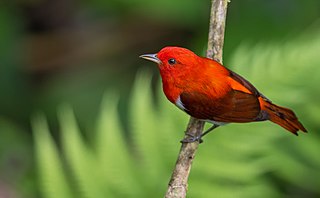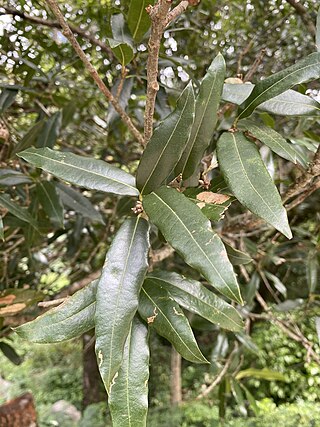The Magdalena tinamou, Crypturellus erythropus saltuarius, is a member of one of the most ancient bird families, the tinamous. It is endemic to the Magdalena River Valley in Colombia, and had been considered possibly extinct, because of an absence of confirmed records since the type specimen was collected in 1943. The most recent review consider it likely that it is extant, as locals have reported sightings in the 1970s and 1980s, an individual was apparently held in captivity until the early 1990s, and a few patches of forest remain in its presumed range. Additionally, a record was made in late 2008. It was rediscovered in 2023.

The Cordillera Central is the highest of the three branches of the Colombian Andes. The range extends from south to north dividing from the Colombian Massif in Cauca Department to the Serranía de San Lucas in Bolivar Departments. The highest peak is Nevado del Huila at 5,364 m (17,598 ft).

The ocellated tapaculo is a large bird found in the northern Andes in South America. It is a highly distinctive tapaculo; traditionally united with its closest relatives in the Rhinocryptidae, this family is paraphyletic with the Formicariidae (ground-antbirds) but instead of merging the tapaculos with the ground-antbird family, recent sources tend to split the antpittas from the Formicariidae.

Centrolene antioquiensis is a species of frog in the family Centrolenidae. It is endemic to Cordillera Central of Colombia and found in Antioquia, Caldas, and Tolima Departments at elevations of 1,850–2,450 m (6,070–8,040 ft) above sea level.
Nymphargus chami is a species of frog in the family Centrolenidae, formerly placed in Cochranella. It is endemic to Colombia where it occurs on the Cordillera Occidental in the Antioquia and Risaralda departments.
Hemiphractus johnsoni, or the Johnson's horned treefrog, is a species of frog in the family Hemiphractidae. It is endemic to Colombia and known from the Cordillera Central in Antioquia and Caldas Departments as well as from the Cordillera Oriental in Huila Department. Prior to 2001, what now is known as Hemiphractus helioi was included in this species. Its natural habitat is primary cloud forest. It is threatened by habitat loss.

The multicoloured tanager is a species of bird in the family Thraupidae. It is endemic to the mountains of Colombia, and as of 2010 has been categorized as vulnerable (VU) by the IUCN.

The scarlet-and-white tanager is a species of bird in the family Thraupidae. It is found in Colombia and northern Ecuador. Its natural habitats are subtropical or tropical moist lowland forests and heavily degraded former forest. The male is highly distinctive and has bright scarlet upperparts, darker red wings and undertail coverts, and white underparts with a scarlet median stripe running down the throat and belly. Females are patterned like the males, but are olive-brown instead of scarlet.

The chestnut-bellied flowerpiercer is a species of bird in the family Thraupidae. It is endemic to Colombia.

The white-mantled barbet is a species of bird in the family Capitonidae. It is endemic to Colombia.

The Santander dwarf squirrel is a small tree squirrel endemic to Colombia.
Cueva de los Guácharos National Natural Park is the oldest national park in Colombia. Located in the western face of the Colombian Eastern Andean Range in the departments of Huila and Caquetá, the park covers an area of 9,000 hectares. The caves formed from the karstic zones of the Magdalena and Caquetá rivers.

Quercus humboldtii, commonly known as the Andean oak, Colombian oak or roble, is a species of oak found only in Colombia and Panamá. It is named for Alexander von Humboldt.
Quercus hirtifolia is a rare Mexican species of oak. It has been found only in a small region of the southern Sierra Madre Oriental in northern Puebla and eastern Hidalgo states in east-central Mexico.

The Cordillera Oriental montane forests (NT0118) is an ecoregion in Venezuela and Colombia along the east slopes of the eastern cordillera of the Andes. The extensive region of submontane and montane forests includes distinctive flora and fauna in the north, center and southern sections. The ecoregion is home to numerous endemic species of fauna. Despite extensive changes due to logging, farming and ranching, large areas of the original habitat remain intact, and the ecoregion has rich biodiversity.

The Magdalena Valley montane forests (NT0136) is an ecoregion in the Andes mountains of central Colombia.

Quercus cortesii is a species of oak native to Central America and southern Mexico.

Quercus pinnativenulosa is a species of oak endemic to Mexico.
Quercus furfuracea is a species of oak native to eastern Mexico.
Quercus flocculenta is an endangered species of oak in the family Fagaceae, native to northeastern Mexico. It is endemic to the Sierra Madre Oriental of Nuevo León state.













